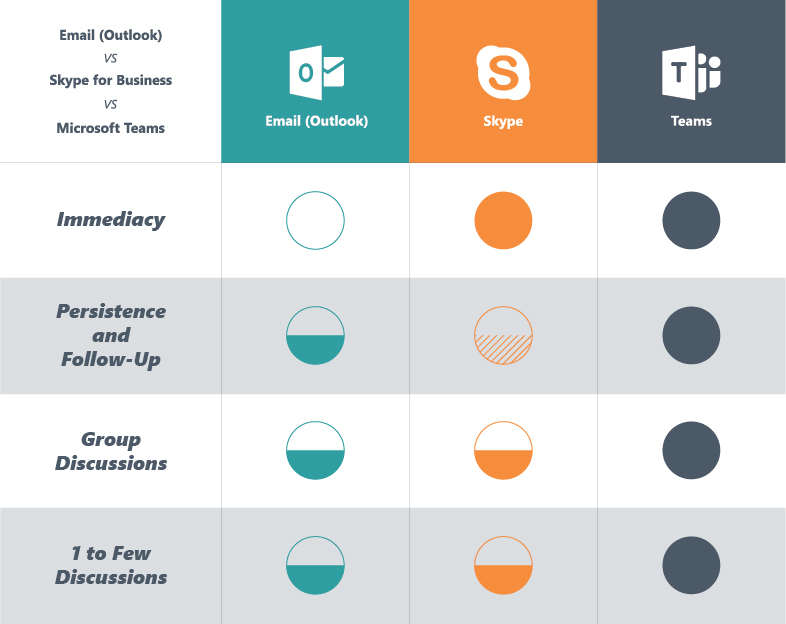
- #O365 skype for business conversation history update
- #O365 skype for business conversation history manual
There is an option to change the chat history preference from the user side as below Server settings and user settings can be checked from here. This option can be checked in File – Options – Outlook in Cisco Jabber Client The Jabber client will use defined autodiscover URL in the config file to search for the Exchange server at one of the following Web addresses: So for this configuration to make it happen automatic we can configure the autodiscover domain parameter in the jabber-config.xml file.Īccess the jabber-config.xml file same as step 1 through TFTP server, configure the ExchangeAutodiscoverDomain parameter. Jabber client uses the Exchange autodiscover for this integration.
#O365 skype for business conversation history manual
But this will be manual process where the server name needs to be entered and not automatic server discovery.Īfter we set the EnableSaveChatHistoryToExchange value to true and decide on the authentication method we need to select an option for the jabber client to reach the exchange server address. If we don’t specify an authentication method, then users can authenticate directly from the Outlook tab in the Options menu of their clients. In this example Cisco UCS is defined as the service which provides the Exchange server with credentials for authentication. With this method, the client will be using the credentials to authenticate to the Exchange server.īelow parameter needs to be updated to sync credentials in Jabber.xml config file We can sync the Exchange credentials with another set of credentials for users which will be the jabber client credentials.
#O365 skype for business conversation history update
Update the jabber-config.xml file with ExchangeAuthenticateWithSystemAccount parameter to true. When we set this the jabber client will use the account details of the logged in user to authenticate with exchange server.It users NTLM authentication method. Post this operation restart the TFTP service on each TFTP server for the update to reflect immediately.Ģ) There is option to specify the authentication settings.Īuthenticate Using Single Sign On for the Operating System: Once this is completed we need to upload the updated file with the same name on each of the TFTP server present in the Cluster. After accessing this URL jabber-config.xml will be downloaded.ī) Update the xml file with EnableSaveChatHistoryToExchange true as below Steps to update the conversation history in the Jabber-config.xml file:Ī) Login to the CUCM TFTP server and access the below URL Having this value to false will not save the conversation history in Outlook. The default value after the installation is set to false in the config file. Here after the integration we can see a folder called Cisco Jabber Chats.ġ) Set the EnableSaveChatHistoryToExchange parameter to true in the jabber-config.xml file. We can enable the Jabber client to automatically save chat histories in Outlook like same how we have conversation history folder option in Skype for Business. That’s a much more user-friendly fix (which worked for me) – and it’s one to add to the project FAQ list.In this article we will have a look at option to integrate the Cisco Jabber with outlook to save the conversation history in outlook folder.

Hope that helps and is typically easier than deleting entries. We provide this as post-migration steps to users once we move their mailboxes to 365.

We’ve resolved this by having users sign out of Lync and then choose “Delete my sign-in info”, then just sign back in and their Lync client now connects to 365. One suggestion given to me to force a new autodiscovery search was to wipe the user’s cached client information (in That sounded a little destructive but Richard’s post suggests removing a single registry better though is the solution from a comment on Richard’s blog post, from “Chad”: If we looked at the configuration information for the Lync client (by Ctrl+right clicking on the Lync taskbar icon), we could see that the client was not autodiscovering the move to Exchange Online and still showed on-premises Exchange details, instead of a blank EWS Internal URL and an entry of for the EWS External URL. The reason for this is unclear but I’m not the only one who’s experienced it – Richard Brynteson describes exactly the same scenario where, after a migration from an on-premises Exchange mailbox to Exchange Online, the Lync 2013 client is unable to connect to the Exchange server and pull conversation history and meeting information. In addition to the challenges created by the unified contacts store, my recent Office 365 migration project saw some issues where a user’s Lync/Skype for Business client failed to pick up a change in Exchange Web Services (EWS) as part of the move to Skype for Business Online.

Please be warned that the information here may be out of date. I don't routinely update old blog posts as they are only intended to represent a view at a particular point in time.


 0 kommentar(er)
0 kommentar(er)
